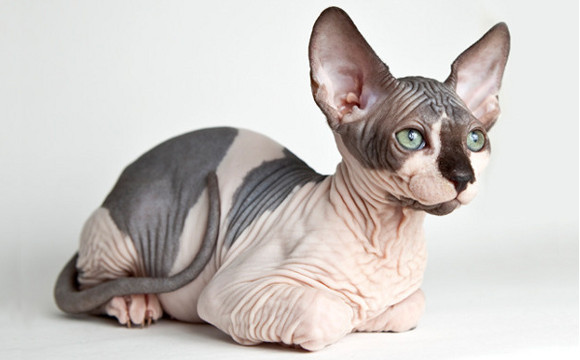History
The Sphynx is not the first instance of hairlessness in domestic cats. This natural, spontaneous mutation has been seen in various locations around the world for at least the last ninety-something years, and probably longer. The Book of the Cat (Simpson, 1903), mentioned a pair of hairless cats belonging to a New Mexico fancier. Called the “Mexican Hairless”, these cats supposedly were obtained from Indians around Albuquerque.
In 1950 a pair of Siamese cats in Paris France, produced a litter that included three hairless kittens. The results were repeated in subsequent matings of the same pair, but breeding the parents to other Siamese cats produced no new hairless kittens.
Other hairless specimens turned up in Morocco, Australia, North Carolina, and, in 1966, in Canada, where a pair of domestic shorthairs produced a litter that included a hairless kitten. A breeder named Ryadh Bawa obtained the parents and, with the help of other breeders, began a breeding program. The CFA originally granted New Breed and Color status, and then in 1971 they withdrew recognition due to infertility problems with the breed. This line was not pursued after 1980 and is not part of the current bloodline.
The Sphynx Cat Breed: A Comprehensive Guide
Introduction
The Sphynx cat, known for its hairless appearance, is a unique and fascinating breed with a rich history. This article delves into the origins, characteristics, and care requirements of the Sphynx cat, providing a thorough understanding for potential owners and cat enthusiasts.
History of the Sphynx Cat
The Sphynx cat’s hairlessness is due to a natural, spontaneous mutation. Instances of hairless cats have been recorded globally for over a century. In 1950, a pair of Siamese cats in Paris produced hairless kittens. However, the breed as we know it today began in 1975 on a Minnesota farm when a hairless kitten named Epidermis was born to a normal-coated cat. Epidermis, along with another hairless kitten, Dermis, became the foundation of the breed through the efforts of breeders in Oregon and Minnesota.
Breed Development
The Sphynx breed was further developed when Canadian breeder Shirley Smith discovered three hairless kittens in her neighborhood in 1978. These kittens, along with others from Minnesota and Oregon, formed the basis of today’s Sphynx breed. Crossbreeding with the Devon Rex and American Shorthair widened the gene pool, crucial for the breed’s development.
Physical Characteristics
- Appearance: Despite appearing hairless, Sphynx cats have a fine layer of down that gives their skin a chamois-like texture. Their skin can be any color or pattern that would be seen in a furred cat.
- Wrinkles: Wrinkles are a desirable trait in show cats, not because they are more wrinkled than other cats, but because the lack of fur makes them more visible.
- Size and Build: Sphynx cats are medium-sized with a muscular build, large ears, and prominent cheekbones.
Personality and Temperament
- Affectionate: Sphynx cats are known for their affectionate and sociable nature. They love to be the center of attention and are very people-oriented.
- Playful: They are highly active and playful, often performing acrobatic feats around the house.
- Intelligent: This breed is intelligent and curious, often exploring their surroundings and interacting with their human companions.
Care Requirements
- Grooming: Regular grooming is essential for Sphynx cats due to their lack of fur. They need frequent baths to remove the oily secretions that would normally be absorbed by their fur.
- Skin Care: Special attention must be given to their skin to prevent oil buildup, which can lead to skin problems.
- Diet: A balanced diet is crucial to maintain their energy levels and overall health.
- Temperature Sensitivity: Sphynx cats are more sensitive to temperature changes and should be kept in a warm environment.
Health Considerations
- Common Health Issues: Sphynx cats are generally healthy, but they can be prone to certain conditions such as hypertrophic cardiomyopathy (HCM) and skin infections.
- Veterinary Care: Regular veterinary check-ups are important to monitor their health and prevent potential issues.
Sphynx Cats and Allergies
While they don’t shed hair, Sphynx cats can still trigger allergies due to the allergenic protein Fel d1 found in their saliva and sebaceous glands. Regular bathing can help reduce the allergen load.
Conclusion
The Sphynx cat is a unique and affectionate breed that requires specific care due to its hairlessness. With proper grooming, diet, and attention to their health needs, Sphynx cats make loving and playful companions. Their striking appearance and engaging personalities have won them a dedicated following among cat lovers.
SEO Tips for Your Sphynx Cat Content
To optimize your content for SEO, consider the following tips:
- Keywords: Use relevant keywords such as “Sphynx cat care,” “hairless cat breed,” and “Sphynx cat health” throughout your article.
- Headings: Break down the content with clear and descriptive headings and subheadings.
- Internal Links: Link to other relevant articles on your website to improve navigation and SEO.
- External Links: Include credible external links to authoritative sources on cat care and health.
- Meta Description: Write a concise and compelling meta description incorporating your primary keywords.
- Alt Text: Use descriptive alt text for images to enhance SEO and accessibility.
- Engaging Content: Ensure your content is engaging and informative to keep readers on your page longer, reducing bounce rates.
- ☆☆☆☆☆☆☆☆ Activity
- ☆☆☆☆☆☆☆☆☆☆ Playfulness
- ☆☆☆☆☆☆☆☆☆☆ Need for Attention
- ☆☆☆☆☆☆☆☆☆☆ Affection
- ☆☆☆☆☆☆☆ Need to Vocalize
- ☆☆☆☆☆☆☆ Docility
- ☆☆☆☆☆☆☆☆☆☆ Intelligence
- ☆☆ Independence
- ☆☆☆☆☆ Healthiness and Hardiness
- ☆☆☆☆☆☆☆☆☆ Grooming needs
- ☆☆☆☆☆☆☆☆ Good with children
- ☆☆☆☆☆☆☆☆ Good with other pets

